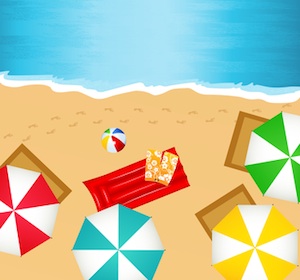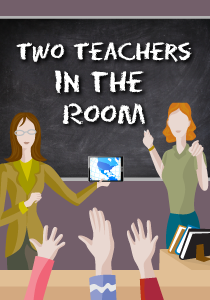Sun, Fun and UDL
A MiddleWeb Blog
As the school year comes to a close, teachers everywhere think about how students have evolved over the school year.
We say, “Wow, Tyler really improved his writing skills.” “Lauren really built her stamina for reading longer texts.” Additionally, we say things like, “I wish we had more time to guide Maya through understanding those math concepts until she was more independent in applying them.”
We think about students as individuals. And why wouldn’t we? That’s exactly what we are supposed to do. And we know that the key is to use our knowledge of our students’ individual needs and strengths all year long to provide effective instruction. That’s what the Universal Design for Learning helps us to do. UDL guides educators to truly understand and design for learners’ needs. UDL is all about learner variability. And for me, there is no other way I want to teach.
But I know, I know, summertime is here. It’s a time to have barbecues, go on vacations, visit with friends, read our list of summer reading books, and take trips to the beach. So what am I doing talking about UDL? Now that summer is here we should be in “beach and pool” mode. I say we do both.
Summertime…and I’ve got planning on my mind
Even though it’s summer, it’s also a time when we begin to plan for the upcoming school year. And for me that means I’m thinking about UDL — constantly! Not surprisingly, I see connections everywhere–even on a typical relaxing summer day.
Through my passionate study of UDL over the past few years, I’ve noticed that the use of analogies is an effective way to introduce the concept of UDL to those new to the idea.
 Todd Rose, the co-founder and president of Project Variability as well as a faculty member at the Harvard Graduate School of Education, shares this video about the necessity for considering learner variability through all phases of the learning process.
Todd Rose, the co-founder and president of Project Variability as well as a faculty member at the Harvard Graduate School of Education, shares this video about the necessity for considering learner variability through all phases of the learning process.
Rose uses two effective analogies ( a shoe, and a Rubik’s cube) to bring forth the value of variability. Here’s another analogy I’d like to offer…
Now that summer is here, it’s easy to imagine a beach. I know it’s easier for me than some colleagues in the midwest, since I live on Long Island NY. But go with me here for awhile. If you’re not near a beach, think “lake” or “community pool.”
Let’s connect our water-related recreation to the fact that UDL is about “removing barriers in the learning environment” so that all students have access to the information in a way that maximizes student’s strengths and ability to learn.
Our trip to the beach
Imagine a trip to the beach. A typical person would need items such as:
- a bathing suit
- towel
- blanket
- water
- snacks/lunch/beverage
- sunscreen
- a watch to keep track of time
- book
Now let’s take a closer look at some of these items on the list as we imagine a group of 25-30 people going to the beach. Consider the bathing suit. (This analogy may seem a bit crazy, but I think it’s one you will never forget. The mere absurdity of it alone will create a strong memory gem to help you to remember the necessity of UDL in the classroom!)
It goes without saying that we would never expect a group of 30 people to wear the same style or size bathing suit. Just plain ridiculous. We also would never expect the same group of 30 to pack the same snack, lunch, or beverage. There are many variables that result in the fact that people need to pack different foods and beverages. And we can be pretty certain that in this group of 30 some will want to tan and use a low-SPF sunning lotion, while others will range up to 50 or even 100 SPF.
 Now think of your favorite beach read. Again, we would never expect this group of 30 to read the same book at the beach. Just plain silly, unless you’re planning a particularly sandy meeting of your book club.
Now think of your favorite beach read. Again, we would never expect this group of 30 to read the same book at the beach. Just plain silly, unless you’re planning a particularly sandy meeting of your book club.
I think you see where I’m going with this, don’t you?
Let’s take a group of 30 students. Why would we expect all 30 to experience the learning process in the same way? We would never expect our 30 beach goers to experience their hours at the beach in the same way. Some people would want to stay in direct sun the whole time, some swim, some sit under the umbrella, some read. The process of experiencing the objective of having a relaxing day at the beach is different for all–but the overall objective is the same–relaxing at the beach.
Individual variability is expected, honored, and embraced for a group of 30 beach goers. It should be just as easy for us to see that individual variability needs to be honored and embraced for a group of 30 different learners in the classroom.
Summer plans can pave the way for UDL
In addition to my plans for enjoying the lazy days of summer, my plans include participating in this online UDL summer course. I’ve been reading about and researching UDL on my own for the past few years, and I’m excited to formalize my understanding.
In addition, I invited one of my co-teachers (the one I mentioned in this post) and she agreed to join me! The slow and steady steps I am taking to bring the UDL mindset to my district are beginning to produce that collaborative feel I’ve been hoping for. And that’s how positive change happens–with collaboration!
Here’s how you may get started
- Visit the Center for Special Technology website (CAST) to peruse and delight in the art of considering learner variability.
- Read my past post, “Chiseling a Teaching Masterpiece” to get the gist of UDL from a practical classroom perspective.
- Create a free account at CAST UDL Lesson Builder to begin thinking about how to plan your lessons the UDL way!
- Join Mindy Johnson, Katie Novak, Ron Rogers, Kit Hard and me for our Twitter chat on UDL. It is the 1st and 3rd Thursday of each month. Our next chat is Thursday 6/20, from 8:00-8:30 EST. Use #udlchat to join in on the rich discussions! See you there!
And my hope is that the next time you plan your trip to the beach, you will feel a mysterious urge to start planning for learner variability for the upcoming school year!
The best part is, you do not have to do it alone. Find colleagues to plan with, find online sources to help you. And PLEASE come back here to share your experiences, ask questions, and support colleagues. Collaboration is the only way. Until we meet again…


































